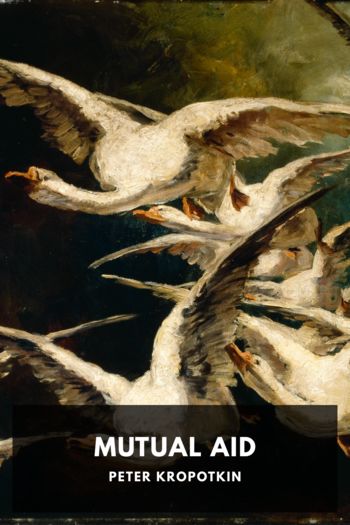Mutual Aid, Peter Kropotkin [fiction novels to read .txt] 📗

- Author: Peter Kropotkin
Book online «Mutual Aid, Peter Kropotkin [fiction novels to read .txt] 📗». Author Peter Kropotkin
Many striking pages could be written about the harmony which prevails in the villages of the Polynesian inhabitants of the Pacific Islands. But they belong to a more advanced stage of civilization. So we shall now take our illustrations from the far north. I must mention, however, before leaving the Southern Hemisphere, that even the Fuegians, whose reputation has been so bad, appear under a much better light since they begin to be better known. A few French missionaries who stay among them “know of no act of malevolence to complain of.” In their clans, consisting of from 120 to 150 souls, they practise the same primitive communism as the Papuas; they share everything in common, and treat their old people very well. Peace prevails among these tribes.91 With the Eskimos and their nearest congeners, the Thlinkets, the Koloshes, and the Aleuts, we find one of the nearest illustrations of what man may have been during the glacial age. Their implements hardly differ from those of palaeolithic man, and some of their tribes do not yet know fishing: they simply spear the fish with a kind of harpoon.92 They know the use of iron, but they receive it from the Europeans, or find it on wrecked ships. Their social organization is of a very primitive kind, though they already have emerged from the stage of “communal marriage,” even under the gentile restrictions. They live in families, but the family bonds are often broken; husbands and wives are often exchanged.93 The families, however, remain united in clans, and how could it be otherwise? How could they sustain the hard struggle for life unless by closely combining their forces? So they do, and the tribal bonds are closest where the struggle for life is hardest, namely, in Northeast Greenland. The “long house” is their usual dwelling, and several families lodge in it, separated from each other by small partitions of ragged furs, with a common passage in the front. Sometimes the house has the shape of a cross, and in such case a common fire is kept in the centre. The German Expedition which spent a winter close by one of those “long houses” could ascertain that “no quarrel disturbed the peace, no dispute arose about the use of this narrow space” throughout the long winter. “Scolding, or even unkind words, are considered as a misdemeanour, if not produced under the legal form of process, namely, the nith-song.”94 Close cohabitation and close interdependence are sufficient for maintaining century after century that deep respect for the interests of the community which is characteristic of Eskimo life. Even in the larger communities of Eskimos, “public opinion formed the real judgment-seat, the general punishment consisting in the offenders being shamed in the eyes of the people.”95
Eskimo life is based upon communism. What is obtained by hunting and fishing belongs to the clan. But in several tribes, especially in the West, under the influence of the Danes, private property penetrates into their institutions. However, they have an original means for obviating the inconveniences arising from a personal accumulation of wealth which would soon destroy their tribal unity. When a man has grown rich, he convokes the folk of his clan to a great festival, and, after much eating, distributes among them all his fortune. On the Yukon river, Dall saw an Aleonte family distributing in this way ten guns, ten full fur dresses, 200 strings of beads, numerous blankets, ten wolf furs, 200 beavers, and 500 zibelines. After that they took off their festival dresses, gave them away, and, putting on old ragged furs, addressed a few words to their kinsfolk, saying that though they are now poorer than any one of them, they have won their friendship.96 Like distributions of wealth appear to be a regular habit with the Eskimos, and to take place at a certain season, after an exhibition of all that has been obtained during the year.97 In my opinion these distributions reveal a very old institution, contemporaneous with the first apparition of personal wealth; they must have been a means for reestablishing equality among the members of the clan, after it had been disturbed by the enrichment of the few. The periodical redistribution of land and the periodical abandonment of all debts which took place in historical times with so many different races (Semites, Aryans, etc.), must have been a survival of that old custom. And the habit of either burying with the dead, or destroying upon his grave, all that belonged to him personally—a habit which we find among all primitive races—must have had the same origin. In fact, while everything that belongs personally to the dead is burnt or broken upon his grave, nothing is destroyed of what belonged to him in common with the tribe, such as boats, or the communal implements of fishing. The destruction bears upon personal property alone. At a later epoch this habit becomes a religious ceremony. It receives a mystical interpretation, and is imposed by religion, when public opinion alone proves incapable of enforcing its general observance. And, finally, it is substituted by either burning simple models of the dead man’s property (as in China), or by simply carrying his property to the grave and taking it back to his house after the burial ceremony is over—a habit which still prevails with the Europeans as regards swords, crosses, and other marks of public distinction.98
The high standard of the tribal morality of





Comments (0)